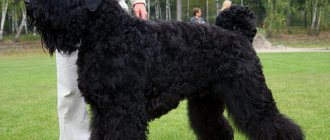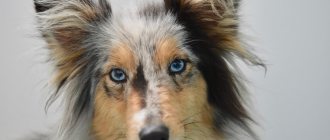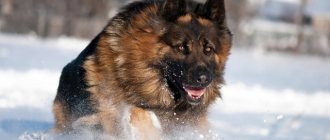Structure of the eye
Anatomically, the visual analyzer of a dog is very similar to that of a human. The cornea is located in front of the eyeball - this is its outer shell. Normally it is clean, transparent and shiny. Its purpose is to protect the eyeball from damage. The outer shell also participates in the refraction of light.
Below the cornea is the middle layer of the eye, the iris. In its center is the pupil, and behind it is the lens. In addition, the iris is formed by a network of blood vessels that supply the eye.
Muscle fibers are attached to the lens. By contracting and relaxing, they change its curvature, providing vision of objects at different distances.
The pupil and lens are directly involved in the visual perception of the surrounding reality. The light flux, passing and refracting through them, hits the retina, where it is converted into corresponding signals.
The retina is the third layer of the eyeball. Its complex design allows you to modify visual impulses and transmit them to the brain. Here the final picture of the world is formed.
In addition to the above-mentioned ocular elements that bring the eyes of animals and humans closer together, there are others that are strictly specific to dogs.
Thus, the eye of tetrapods has an additional outer shell called the third eyelid . This is a thin film that envelops the eye. It protects it from debris and dust. And constantly moisturizes, thanks to the lacrimal gland.
The retina deserves special attention. It is its features that provide a specific vision of the world around the doggies.
As you know, certain cells in the structure of the retina, called rods and cones, are responsible for color perception and orientation in the twilight.
Cones are responsible for color perception of objects during the day, and rods are responsible for visual orientation at night. In tetrapods, rods predominate in the network structure. There are several times more of them here than in humans. As for cones, their number is much smaller.
Also, tailed animals lack the macula macula, which in humans is located in the center of the retina and is a cluster of cones. But there is an additional crystalline layer called tapetum. It plays a special role in the visual adaptation of the animal.
Conventionally, the retina is divided into 2 parts:
- the upper one – provides the dog with visual orientation in the dark and is responsible for visual acuity;
- the lower one is responsible for daytime vision.
The eyes of our beloved pets are designed in such a way as to help them quickly navigate in space and not miss their prey. This is inherent in their original nature as a wild predator and dexterous hunter.
Are the colors different?
The statement that our beloved pets' vision is black and white is false. Dogs see and analyze the world around them in different colors, although their palette, compared to humans, is rather meager.
Let's start with the fact that color vision for dogs is provided by the cones of the retina. But their number is negligible.
In humans, there are 3 types of these cells:
- captures long waves of the color spectrum and detects red and orange tones;
- reacts to medium waves of yellow and green colors;
- sensitive to short, blue-violet waves.
Dogs have only 2 types of cones.
Green and red shades are beyond the dog's perception. He perceives them in white or gray colors. But doggies distinguish blue, purple and yellow colors perfectly. Thus, they exhibit selective color blindness, and their vision can be compared to that of people who are color blind.
How, in this case, can we explain the fact that dogs navigate traffic lights? There are even special breeds - guide dogs that accompany people with poor eyesight. The fact is that in this case the guide dog reacts not to a change in color, but to a change in the brightness of the signal. And this helps them to correctly assess the situation.
Dog breeders have more than once noted a change in the behavior of their four-legged pets when they see a certain color. For example, a dog reacted sharply to people wearing yellow clothes. This also confirms that they have color vision.
This dog “preference” for flowers is usefully used by trainers in their work. Using in the process of practice toys and attributes of colors to which their students are sensitive, they manage to achieve positive results much faster.
What colors do dogs see?
If we take our color perception as a reference system, the palette of colors that a dog sees will be less diverse and consist of halftones of two shades. Simply put, a dog's palette is undoubtedly colored, not black and white, although it is, of course, much poorer in colors than ours. To be precise, waves whose lengths range from violet to bluish-violet colors of the spectrum are most likely perceived by a dog as a single bluish color; The yellow-green, yellow-red and orange colors visible to our eyes in a dog will probably merge into a single yellowish color; and waves outside this frequency range will be perceived by the dog's eye as white or shades of gray. In the same way, as some studies confirm, the dog has difficulty distinguishing between greenish-blue and gray or yellow-green, yellow, orange and red colors among themselves. Therefore, guide dogs deserve deep respect for the fact that they can cope with our traffic lights... Of course, they rely more on the location of the light signal than on its color. You shouldn’t be surprised that your dog will be slightly annoyed when he fails to find the plastic carrot thrown to him on the green lawn the first time. She will have to work hard to find the toy and bring it back. And this will not happen because the dog sees poorly or doesn’t try hard enough. It's just that the contrast of these two colors is obvious to us, but not to her.
However, one should not make hasty conclusions that the dichromatic vision of dogs, which may seem too meager and dim to a person, certainly means a deficiency and even inferiority. In particular, this type of vision is much more effective against mimicking animals than human multicolor vision. It makes it easier to recognize a disguise and not fall for the tricks of imitators, while those with multicolor vision are much easier to deceive in this regard. For predators, the ability to expose the tricks of a potential victim is of great importance. We hope you learned what colors dogs distinguish and how their vision works.
How does lighting affect?
A dog's vision is universal, since this animal can navigate satisfactorily both day and night.
Orientation in the dark
Dogs have fairly well developed night vision. This is achieved by rods, which are present in large numbers in the structure of the retina. It is so large that dogs see at night and distinguish objects four times better than people.
The already mentioned tapetum helps dogs see perfectly in complete darkness. This is a reflective membrane, which is compared to the glow of headlights or mirror coating. It is located in the upper part of the retina, responsible for night vision.
Light passing through the retina is reflected on it through the membrane again. Thus, the image is clearer and more contrasty.
Animals see objects at night in gray. And they differentiate, almost all of its 50 shades.
Daylight
During the day, four-legged animals also navigate well. And, I must say, this is easier for them than for people. The human eye is sensitive to too bright light. It’s hard for us to look at the sun with our eyes wide open; we have to squint.
In dogs, the lower part of the retina contains a dark pigment that allows it to neutralize the excessive flow of bright light. Therefore, they are much less susceptible to harsh light.
Range and breadth of vision
In addition to the fact that dogs do not perceive a decent range of colors and are perfectly oriented in the dark, their vision also has other features. This time they are related to clarity and breadth of perception.
The dog cannot boast of visual acuity. The reason for this is the absence of a yellow spot on his retina, characteristic of the human eye. This is where a large number of cones are concentrated. Thanks to the macula, we are able to see objects both near and far (if we are talking about a healthy person).
The retina of dogs is devoid of a macula, and therefore their visual acuity is poor.
In order for a dog to clearly see any object, it must be at least 30 cm away from it. From which it was concluded that the visibility of these animals is akin to people with a slight degree of farsightedness. However, despite the difficulty of focusing on nearby objects, dogs are adept at judging the distance to a target.
Another property of the dog's eye is the perception of a moving object. The dog can identify it at a distance of 900 m. An excellent property for hunting breeds. But if the same target is immobilized, then the tailed animal will be able to see it no further than 600 m. The visibility of objects in dynamics is ensured by a large number of rods in the dog’s retina.
They also determine the panoramic vision of quadrupeds. That is, they perceive the image with the entire retina due to the absence of the macula.
As for the latitude or field of vision, in dogs it averages 250°. This is significantly more than that of a person. And it depends on the location of the visual axis of both eyes. In animals they diverge at an angle of 20°, but in humans they are parallel. A large degree also affects the shape of the visual field. It is not round, like a human one, but has an oval outline, which becomes a significant advantage during hunting - it allows you to view a larger space.
But the field of view is not the same for all breeds. This indicator changes based on the structure of the dog’s skull. The narrower the muzzle and the longer the nose, the higher the degree of visual latitude.
What kind of vision do dogs have?
Visual acuity in dogs is also three to four times worse than in humans. This means that to identify an object, a dog needs to approach it approximately 6 m, while twenty-two will be enough for us. We can say that it is pointless to expect dogs to respond adequately to small objects that are too distant from them. However, in the central zone of the retina, they have a fairly significant accumulation of cones - cells that determine visual acuity, which provides dogs with very good vision in a narrow horizontal stripe. This feature, common to dogs and wolves, may be due to the advantage it provides to predators pursuing prey: they need to accurately determine the distance to their prey.
The dog's eye has a lower capacity for accommodation than the human eye, which has a surprisingly high capacity. Thus, dogs will not be able to clearly see an object located closer than 40 cm from the eyes - this distance varies from 33 to 50 cm depending on the individual characteristics of the dogs, while a person can see an object 7-10 cm from the eyes with sufficient clarity. This is one of the reasons why a dog would rather sniff a very close object than look at it. Therefore, it is useless to slip an object that smells nothing under the dog’s nose: it will not be able to visually identify it; In addition, she will be hampered by her muzzle, which in most breeds obscures the lower part of her field of vision.
As for night vision, in dogs, just like in wolves, it is developed much better than ours. At dawn or dusk, in the hour between wolf and dog (a Latin idiomatic expression for twilight, that is, the time when it is difficult to distinguish a dog from a wolf) and even more at night, dogs see much more keenly than we do. This sensitivity to the weakest light is explained by the presence in them, just like in cats or horses, of a layer of special cells, tapetum lucidum, located behind the retina, which, like a real mirror, reflect and direct even the weakest rays of light onto the retina. In extremely low light conditions, this system makes it easier to capture photons and thus distinguish objects. Perhaps we are talking about a mechanism that canines inherited from the nocturnal lifestyle of the first mammals and which underwent evolutionary selection thanks to the predatory specialization of recent ancestors of dogs: if darkness allows the prey to hide, it also allows the predator to find its prey.
Another feature of canine vision is undoubtedly associated with predation: the dog's eyes are very sensitive to movement, probably more than ours. Indeed, a predator must be able to recognize potential prey from afar even before it has time to notice it. Since the victims of a predator are animals, that is, creatures that are by definition mobile, for a successful hunt it is important for the predator to be able to capture their movements. Despite the fact that a lot of uncertainty remains in this matter to this day, it can be considered established that dogs are able to recognize a moving object located at a distance of 800 or 900 m from them. Moreover, when it comes to stationary objects, the ability of dogs to visually distinguishability drops to 500-600 m.
In addition, the dog's eye has better temporal resolution than ours. The light stimulus continues to act on the retina for some, albeit very short, time. During the duration of one stimulus, the retina remains blind and does not perceive other light signals. So, if two identical but different light stimuli, such as two flashes, are separated by a very short period of time, we will see them as one light signal. This phenomenon explains our perception of a film as continuous action, when in fact it is created from successive frames. Dogs probably need a shorter interval between two flashes than we do to perceive them as two different signals. Therefore, it is quite possible that what dogs see on a TV screen is completely different from what we see: the action perceived by a dog can be compared to what we would see if we were watching a filmstrip with very quickly changing slides.
How do dogs see people and the world around them?
If for a person the eyes are 90% of the information, then for four-legged animals vision is not at all in the first place. Hearing and smell are much more important for them.
Nevertheless, doggies visually adapt well in space . They distinguish individual colors and perceive distant static objects. However, their vision provides certain purposes. Its main task is to fixate on dynamic objects, that is, moving in space.
By the way, it’s not for nothing that they say that when an angry, grinning dog rushes at you, first of all, stop. This will make you less attractive to her.
Dogs living in the wild and domesticated dogs perceive the world around them in the same way. And even beloved pet owners are perceived by them as a blurry outline. A devoted dog recognizes its owner from thousands not by facial features, eye color or nose shape, but by completely different criteria.
Interestingly, in 1 second a dog’s eye perceives 80 frames. Compared to a human, this is 56 frames more. Therefore, four-legged friends are not at all interested in TV, because the frame rate in it is 60 Hz. The picture on the screen appears as a blurry spot on the screen.
Although some modern TVs have a frequency of 100 Hz and are available for viewing by dogs. Currently, developments are underway to create “dog” programs. They will help four-legged animals pass their leisure time when their owners are busy.
How do wild dogs see?
Nature has established that all wild fauna have better vision than domestic animals. This is explained simply, in nature, in wild conditions, only the strongest survive, and accordingly, strict genetic selection is carried out. In addition, wild representatives constantly train their skills in the field of vision and hunting.
But judging by how abandoned pets see themselves, it is clear that they are not much better than pets. Based on the perception of color, we can say that wild representatives, such as wolves, perceive the color spectrum, just like an ordinary representative of the canine family.
Main differences from human vision
The structure of the organ of vision in humans and dogs is very similar. And they coincide in all main indicators. But small differences make a dog’s and a human’s vision of the world around them fundamentally different.
- Their main difference is the difference in color spectrum. In humans, it is much more extensive, which is due to the greater variety of cones.
- The predominance of rods in furry animals helps them navigate in the darkness of the night several times better than a person, while distinguishing objects in fairly clear outlines.
- The visual acuity of furry animals is significantly lower than that of humans.
- But dogs can boast a field of vision that is 70° greater than that of humans.
- Human vision is perfect. Allows you to see near and far, separate a sea of colors and shades, perceive objects of any size and configuration. The dog's eye has trouble seeing close up. And instantly perceives moving objects.
These are the main criteria that distinguish our vision from a dog’s. Such differences are caused, first of all, by the purpose of the organ of vision, which has different meanings for us and for them.
How to test your eyesight
The eyes of tailed animals, like those of humans, undergo changes that can cause destructive processes and decreased vision. There may be several reasons for this: age, injury, certain diseases, including infections.
You can recognize a visual problem in your pet even at home. To understand that your dog's eyes are not in order, first of all, the appearance of visible changes in the organ itself will help. This may include excessive discharge from the eyes, watery eyes, drooping of the upper eyelid, redness or clouding of the eye. Such phenomena almost always affect the ability of visual perception.
You can understand that an animal has become unable to see well by its behavior. Elementary, watch how the dog moves. If she has vision problems, her movements will become timid and uncertain. The pet will begin to bump into corners, and it will be difficult for him to fit into the doorway.
Comments from Vinnie's fans
“Her eyes look like a Disney character's eyes.”
“This dog doesn't even look real! Looks like a Disney character"
"She's like a Disney princess"
View this post on Instagram
Welcome home me :)) finally at my forever home?
A post shared by The Life Of Winnie ? (@winnie_thecocker) on Dec 24, 2021 at 2:47pm PST
Dog vision and testing
It's no secret that animals feel and see the world differently than people. At the same time, in order to better understand your pet and create more effective training programs, it is important for the owner to imagine how dogs see, how they hear, what they respond best to, etc. After all, for example, what colors dogs recognize determine what shades the shells and retrieval items should be. Given the importance of these issues, we decided to publish a series of articles devoted to the sense organs of animals. In this material, we talk about what kind of vision dogs have, and we will talk about hearing and smell in subsequent publications.
How do dogs see: color or light?
Many owners are interested in whether dogs see in the dark and whether it is true that dogs have black and white vision, and if not, how do they see the world? To answer all these questions, let us remember that, like you and me, in our pets special photoreceptors located in the retina of the eye: rods and cones are responsible for recognizing color and light. Only the number of these receptors and their set are different in humans and dogs - therefore, we also see differently.
Thus, color vision is provided by cones (they are also called the organ of daytime vision). Dogs do not have many cones, so they can, in principle, distinguish colors, but only to some extent. Thus, if you have two identical toys, one is sky blue and the other is cornflower blue, then they will be almost the same color for your pet, and the animal will distinguish them by other characteristics, for example, by smell.
Let us also note that humans have three types of cones: for the red-orange part of the spectrum, yellow-green and blue-violet. Dogs do not have cones responsible for red-orange colors, and this further narrows the palette: instead of the rainbow we are used to, they would see a transition from blue to yellow through white. That is, for dogs the most contrasting colors are blue and yellow , and this should be taken into account in training, for example, when choosing colors for equipment.
On the other hand, dogs have much better developed light (or night or twilight) vision. This means that animals need less light to determine the shape and size of an object, the speed and direction of their movement. Due to this, dogs see at night and in the twilight much better than people: when for us objects merge with darkness, our pets clearly see each of them and perfectly navigate the terrain.
Thus, rods provide good black-and-white vision with various shades of gray, and a small number of cones dilute this palette with other colors. Therefore, it is still incorrect to say that dogs see everything exclusively in black and white. Note that these features of dogs’ vision are due to the fact that in the wild they are active even at night, and from an evolutionary point of view, it is more important for them to see well in the dark than to distinguish color nuances.
An interesting fact is that the “glow” of dogs’ eyes is associated with the structure of the retina. The fact is that they, like other nocturnal animals, have another layer of crystals and filaments between the layer of rods and cones. It reflects the light falling on it, which is why it seems to us that the eyes are glowing.
How dogs see
The reaction speed of these animals is explained not only by nervous activity, but also by the fact that they see much more clearly and farther than people.
This is especially true for hunting dogs, since their physical characteristics are supported by powerful instincts.
Photosensitivity
High photosensitivity, as already noted, is explained by two types of membranes under the retina.
That fabric, which has a light and smooth structure, reminiscent of mother-of-pearl, reflects a minimal amount of light and helps your pet see clearly even in very poor lighting conditions.
However, these animals cannot be classified as nocturnal, because in daylight they see approximately the same as humans, thanks to a part of the membrane covered with a dark pigment.
This part perceives images well in bright light conditions.
Thanks to this dual structure, dogs can be considered transitional animals - their vision works well both during the day and at night.
Definition
The number of cones in the eye is responsible for the sharpness of vision. Due to the fact that dogs do not have a yellow spot, they see everything more blurred than humans. At least at short distances. By human standards, dogs suffer from myopia.
When it comes to caring for a dog, it is important to know how to toilet train a dog, how to care for its fur using a furminator, how estrus and mating occur in dogs, how to train a dog at home, and whether castration is necessary.
On the ophthalmologist's chart, they could only read the large third row of letters. The thing is that with a dog’s lifestyle, special clarity of the picture is not needed.
You need to determine the distance to a moving object, the sounds it makes and its smell in order to identify whether it is prey in front of you or an enemy. Vision, especially near vision, takes third place in the ranking of sense organs in these animals.
Did you know? In 1903, two friends decided to cross North America by car. There were few cars in those years, and those that were in use were extremely noisy and smelled terribly of fuel. All these factors clearly add to the heroism of the dog named Bud, who got into the same car with his owners and made this long journey as the third member of the car crew. Bud became the first dog in world history to travel such a long distance in a car.
Color spectrum
Contrary to popular belief, the world around dogs is colored, not black and white. They just don’t perceive or see some colors, so the shades of the world around them are somewhat different due to their vision.
Dogs lack those cones that are responsible for capturing long light waves.
Therefore, the red color and all its derivatives, including orange and yellow, are replaced by blue and green shades for dogs, and they see weak colors like beige, soft blue and soft pink simply as white.
At the same time, these animals distinguish shades of gray and black perfectly, since their twilight vision is four times better developed than that of humans.
Depth and field of view
These indicators depend not only on the structure of the eye, but also on their placement in the skull. Depth equals the concept of volume, multidimensionality and perspective. Dogs have such a great depth of vision that they do not perceive flat images on sheets of paper.
Depth lies in the ability to estimate the distance to an object and the speed of its movement in space, and for predators this ability is the key to survival success.
Despite the fact that dogs' depth is three to four times better developed than that of humans, they pay attention only to moving objects.
If a person sees a motionless creature or object from six hundred meters, then a dog, even from thirty meters, will not pay attention to a motionless object, since it does not make sounds and does not smell anything.
If an object moves, the animal will notice and identify it even from a kilometer away, so it is not recommended to run away from dogs.
As for the field of view, in dogs it has the shape of an ellipse, in contrast to the circular one of humans. In addition, the greater the angle of divergence of the eyes, the more extensive and extended the picture becomes visible.
For example, hunting greyhounds, with long muzzles and wide-set eyes, can see almost three hundred degrees, while the vision of pugs and bulldogs is reduced to a human one hundred and eighty degrees - all depending on the specification of the dog.
Hunting dogs include the Jagd Terrier, Deerhound, Chesapeake Bay Retriever, Rabbit Dachshund, Russian Greyhound, Drahthaar, Flat-Coated Retriever, and Rhodesian Ridgeback.
Important! Greenish mucous discharge from the eyes may indicate that your pet is infected with distemper. This is a rapidly developing disease in which a dog's life is counted in hours, not days. If you notice that your dog is getting weaker and his eyes and nose are covered in green mucus, call the vet immediately.
Features of dog vision: range and latitude
In addition to cones and rods, there are other receptors in the retina that detect the movement of objects, the appearance or disappearance of a light signal, and other factors. However, the eye, as a dog’s organ of vision, only receives information, and its direct processing occurs in the head - in particular, the brain is responsible for forming a single picture from data received from both eyes (remember that each of them looks “separately”, and only then images are combined ). In addition, from individual fragments obtained from looking in different directions and when focusing on different objects, a complete picture of the surrounding space is formed. The brain centers located in the occipital cortex are responsible for this work.
The fact that dog and human vision is binocular (that is, formed from partially duplicated data coming from two eyes) helps us distinguish between reliefs, see in depth and determine the distance of an object from the eyes. Moreover, unlike humans, a dog’s retina does not have a central fovea, the area of maximum visual acuity in which cones are concentrated. For this reason, the animal does not make rapid eye movements following a moving object - your pet does not have such a need, since he sees well with his entire retina.
However, the absence of such a spot makes the dog's vision less sharp. So, she sees medium-sized objects at a distance of 100-150 m. This is not too far, but this does not matter for the dog, because it reacts much more sensitively to movements (which is what it is supposed to do as a predator). In particular, your pet perfectly distinguishes the movements of another animal or person, including perfectly reading the trainer’s gestures or facial expressions. For comparison: a dog can distinguish a running person at a distance of up to 400 m, and after certain training - up to 800 m. In turn, if a person does not move, then the dog may not notice him even at a distance of 100 m, until he detects him by smell.
A dog's view: how your pet sees the world
Contents hide
A dog's view: how your pet sees the world
Have you ever thought about the colors and how exactly your beloved dog sees the world? Even though your four-legged friend's eyes are human-like, his perception of reality is not entirely the same as ours. So what is this dog vision?
Dogs perceive the world through their noses, not their eyes.
If people had to name the sense that is most important for orientation in the world, many would choose vision. Human language is focused on the visual perception of reality: we “see” a point in the distance or share different “views” on a topic. But dog vision is a completely different use of this meaning. Dogs, unlike humans, rely primarily on hearing and smell to assess the situation they are in. So, for example, when a person buys a smartphone, the first thing they will pay attention to is its appearance, and a dog will start sniffing and only after that will decide whether it likes its smell.
Dogs still see colors
Humans and dogs have the same type of photoreceptors in the retina, called rods and cones. Rods are sensitive to changes in light and are responsible for twilight vision: they help us distinguish shapes and movements. Cones allow a person to distinguish one color from another and enjoy its shades. So what is the difference between a human and a dog's ability to identify colors if they have the same photoreceptors? The thing is that in the human retina there are three types of cones that are sensitive to red, blue and green colors. Dogs, on the other hand, have two types of cones, and they can mostly only see yellow and blue colors, as well as shades of gray. Thus, researchers claim that red appears dark gray or even black in the eyes of dogs. She perceives green as a shade of yellow, similar to orange.
In addition, the scientists note, humans have about 6 million cones in their eyes, compared to 1.2 million in dogs. This means that we can distinguish approximately a million different shades of color, but our pets can only distinguish 10 thousand. But they see much better than us at night, and also have a wider range of peripheral vision.
Dogs do not see clearly, but accurately
Another difference between dogs and people in their view of the world is that they do not have clear vision. Dogs are naturally myopic, and their average visual acuity is much worse than that of humans. For example, the human eye, when assessed using letter tables, gives a result of 20/20, and dogs in a similar test using thin lines showed 20/75. This means that if a person with one hundred percent vision clearly sees an object from a distance of 9 meters, then for a dog to see it just as clearly, this object must be at a distance of 3 meters. This explains why the dog cannot recognize you or other family members from a distance. She only sees the outline of a figure until she approaches you or smells you.
This feature is worth keeping in mind when working with your pet at a distance: some trainers even suggest using your hands to make it easier for the dog to understand your command. And this is reasonable: they are 10-20 times better at distinguishing movements at a distance than people.
All that remains is to add: we are so different, but still we are together!
Photo source: https://pixabay.com/ru/
Dog vision test
Just like in humans, dogs' vision can deteriorate due to old age, injury, or various diseases. For example, in some animals, significant problems (even complete blindness) arise due to plague. At the same time, often - again, as in people - such problems do not affect the way the eyes look. Then how do you know if your pet can see well?
There are several simple methods for determining a dog’s vision that every owner can try. First of all, pay attention to the behavior of the animal: a dog with normal vision can freely navigate the surrounding space and does not bump into walls, corners or other obstacles. If your pet has problems getting through a door or around an unexpected obstacle on the road, there is a high probability that his eyesight is failing him.
To test whether a dog can see, place your hand near his eyes without touching his eyelashes and observe his reaction. If it does not follow, and the pupils do not react to light (do not dilate when you block the light with your hand, and do not narrow when you remove it), then the animal definitely has serious vision problems.
Another test method: tie the dog and move away from it at a distance of 10-15 meters. Then call her and make a few familiar gestures or throw a fetch object. A dog with good vision will react accordingly, but a dog with poor vision will not show any reaction.
Remember to always consult your veterinarian if you have any questions, suspicions or concerns.
Dog popularity on social networks
Thousands of adoring followers call her “cute” and “sweet.” In addition, the cocker spaniel has gained popularity even among celebrities. The famous singer Rita Ora admired the dog.
A recent photo of Winnie sitting on a tiled floor and staring straight into the camera with wide eyes has prompted comparisons to a "Disney princess." Some people, however, still doubt the dog's photos are real.
View this post on Instagram
Back when I was even smaller than I am now! ? (but equally as cute?)
A post shared by The Life Of Winnie ? (@winnie_thecocker) on Jan 15, 2021 at 10:31am PST
Will never be able to drive a car
The retina of their curious eyes is structured differently from that of humans. It contains much fewer cones responsible for color perception. And there are absolutely no cells whose functionality is to perceive long waves of sunlight. It is believed that the main color that predominates in the picture of the world of our pets is green.
If a dog were to drive a car, an accident would certainly occur. And the point here is not that they could not turn the steering wheel of a vehicle with their paws. The dog is simply not able to distinguish the colors of the traffic light.
Redness of the eyes
The causes of red eyes in a dog can be different:
- allergic reaction (general or local) to certain types of food, dust, plants, medications, etc.;
- a number of eye diseases, including plasmama (as a result a dense, lumpy film appears on the cornea), vascular keratitis (associated with the growth of capillaries into the iris during advanced inflammatory processes), etc.;
- injuries, foreign bodies, infectious diseases, etc.
In most cases, long-lasting redness of the eyes is a dangerous symptom. Owners need to contact a veterinarian as soon as possible. With timely treatment, it is possible to avoid relapses and preserve the pet’s vision, and if hyperemia of the mucous membranes is associated with a disease such as babesiosis, then save a life.
In some cases, emergency eye care may be needed. First of all, we are talking about injuries and possible infection. Eye drops "Iris" is a long-acting ophthalmic antibacterial drug based on gentamicin sulfate. It can be prescribed by a veterinarian for acute and chronic conjunctivitis, keratitis, meibomitis, blepharitis, keratoconjunctivitis, uveitis. As a prophylactic agent in case of injury to a dog's eyes, the drug is instilled into the conjunctival cavity for 3 days. The uniqueness of Iris drops is that they easily penetrate into the intraocular environment and do not allow the development of infection. Before using drops, preliminary consultation with a specialist is recommended.
The angle of view depends on the structure of the skull
It is definitely worth noting the point of view of our favorites. It is much narrower than ours. But this does not mean that they see less than we do. Quite the contrary.
Their frontal viewing angle is indeed narrower. But angular vision is much wider than that of a person. By the way, it all also depends on the breed of the dog. Breeds with wide muzzles and small noses see less, such as pugs and bullmastiffs. Representatives of hunting breeds observe the bigger picture.
In general, their viewing angle is 250 degrees. For comparison, in humans this angle is 180 degrees. This structure is due to the fact that dogs are still predators, albeit domesticated ones. In the wild, to survive, you need to see not only what is in front of you, but also what is happening around you.
How dogs see the world
In addition to differences in color perception, sands have some other features in the perception of the surrounding world. One of the distinguishing features of worldview is that our pets are farsighted. Dogs perceive anything closer than 30-50 cm very vaguely. In this case, they can see a stationary object at a distance of 600-700 meters, and a moving one - at a distance of 900-1000 meters.
But we all know that vision is not the most important sense organ. The most basic are hearing and smell. So when some pet owners claim that their dog loves watching cartoons or football, just smile and agree. After all, you know that the tailed one is not attracted by an exciting action movie, but simply by flickering on the screen or in the mirror.
Well, another distinctive feature of dogs’ vision is the angle and field of view. Despite the fact that their frontal viewing angle is much narrower than ours, their angular image is wider.
Visibility in the dark
These animals see in the dark much better than humans and even cats. They belong to the so-called transitional type of animals. This means that they are neither nocturnal nor diurnal creatures. They see equally well at any time of the day. This is due to the structure of their eyes. The upper part has a material that is capable of reflecting the incident light. This provides the ability to see in the dark. The lower part is capable of absorbing light, thanks to which the animal is able to see even in the brightest light.
Sources:
https://vplate.ru/sobaki/kak-razlichayut-cveta/ https://dogtricks.ru/stati-o-dressirovke/zrenie-u-sobak https://zen.yandex.ru/media/id/5c8c000458588900b4310909 /5ca61fbf1bb26c00b31c60aa










